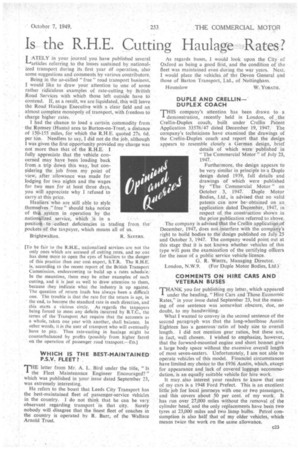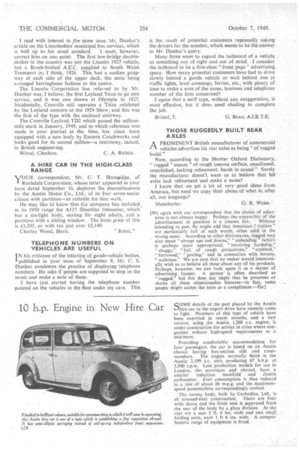Is the RILE. Cutting Haulage Rates?
Page 61

Page 62

If you've noticed an error in this article please click here to report it so we can fix it.
LATELY in your journal you have published several articles referring to the losses sustained by national-, ized transport during its first year of operation, also some suggestions and comments by various contributors.
Being in the so-called " free " road transport business, I would like to draw your attention to one of some rather ridietdous examples of rate-cutting by British Road Services with which those left outside have to contend. If, as a result, we are liquidated, this will leave the Road Haulage Executive with a clear field and an almost complete monopoly of transport, with freedom to ^ charge higher rates.
I had the chance to load a certain commodity from the Romsey (Hants) area to Burton-on-Trent, a distance of 150-155 miles, for which the R.H.E. quoted 27s. 6d, per ton. Needless to say, I did not do the job, although I was given the first Opportunity provided my charge was not more than that of the R.H.E. I fully appreciate that the vehicle concerned may have been loading back from a trip down this way, but considering the job from my point of view, after allowance was made for lodging for two nights and the wages for two men for at least three days, you will appreciate why I refused to carry at this price.
Hauliers who are still able to style themselves " free" should take notice of tint ystem in operation by the nationalized service, Which is in a position to collect deficienCies in trading from thepockets of the taxpayer, which means all of us.
Brightwalton. •R. SAYERS.
[To be fair to the R.H.E., nationalized services are not the only ones which are accused of cutting rates, and no one has done more to open the eyes of hauliers to the danger of this practice than our cost expert, S.T.R. The R.H.L is, according to the recent report of the British Transport Commission, endeavouring to build up a rates schedule. In the meantime, there may be other examples of such cutting, and it is just as well to draw attention to them, because they indicate what the industry is up against. The question of return loads has always been a difficult one. The trouble is that the rate for the return is apt, in the end, to become the standard rate in each direction, and this starts a vicious circle. As regards the taxpayers being forced to meet any deficits incurred by B.T.C., the terms of the Transport Act require that the accounts as a whole, taken one year with another, shall balance. In other words, it is the user of transport who will eventually have to pay. Thus rate-cutting in haulage might be counterbalanced by profits (possibly from higher fares) on the operation of passenger road transport.—ED.] WHICH IS THE BEST-MAINTAINED P.S.V. FLEET? _ THE letter from Mr. A. L. Bird under the title, "Is the Fleet Maintenance Engineer Encouraged?" which was published in your issue dated September 23, was extremely interesting.
He refers to the boast that Leeds City Transport has the best-maintained fleet of passenger-service vehicles in the country. I do not think that he can be very observant regarding transport in that city. Surely nobody will disagree that the finest fleet of coaches in the country is operated by R. Barr, of the Wallace Arnold Trust.
As regards buses, I would look upon the City' of Oxford as being a good first, and the condition of the fleet was maintained even during the war years. Next, I would place the vehicles of the Devon General and those of Barton Transport, Ltd., of Nottingham.
Hounslow W. YORATH.
DUPLE AND CRELLIN—. DUPLEX COACH THIS company's attention has been drawn to a I demonstration, recently held in London, of the Crellin-Duplex coach, built under Crellin Patent Application 33576/47 dated December 19, 1947: The company's technicians have examined the drawings of the Crellin-Duplex coach and report that the design appears to resemble closely a German design, brief details of which were published in "The Commercial Motor " of July 25, 1947.
Furthermore, the design appears to be very similar in principle to a Duple design dated 1939, full details and drawings of which were published by "The Commercial Motor" on October 3, 1947. Duple Motor Bodies, Ltd., is advised that no valid patents can now beobtained on an application dated Decembir, 1947, in respect of the construction. shown in the prior publication referred to above.
The company is advised:that the Crellin applicatiqp.of December, 1947, does not. interfere with the companirs right to build bodies to the design published on .111.4 25 and October 3, 1947. The company would point out at this stage that it is not known whether vehicles of this type will pass the examination of the certifying officers for the issue of a public service vehicle licence. G. R. WHITE, Managing Director.
London, N.W.9. (For Duple Motor Bodies, Ltd.) COMMENTS ON HIRE CARS AND VETERAN BUSES THANK you for publishing my letter, which appeared I under the heading, "Hire Cars and Those Economic Rates," in your issue dated September 23, but the meaning of one sentence was somewhat obscure, due, no doubt, to my handwriting.. What I wanted to convey in the second sentence of the second paragraph was that the long-wheelbase Austin Eighteen has a generous ratio of body size to overall length. I did not mention gear ratios, but these are, in fact, well chosen. I wished to emphasize, however, that the forward-mounted engine and short bonnet give a large body space without the excessive overall length of most seven-seaters. Unfortunately, I am not able to operate vehicles of this model. Financial circumstances have limited my choice to the 1936 Austin, which, except for appearance and lack of covered luggage accommodation, is an equally suitable vehicle for hire work. It may. also interest your readers to know that ode of my cars is. a 1948 Ford Prefect. This is an excellent little job for local journeys with one or two passengers, and this covers about 50 per cent. of my work. It has run over 27,000 miles without the removal of the cylinder head, and the only replacements have been two tyres at 23,000 miles and two lamp bulbs. Petrol congumption is also half that of my older vehicles, which means twice the work on the same allowance. I read with interest in the -same issue Mr. Dunbar's. article on the Lincolnshire municipal bus services, which
is well up to his usual standard I must, however, correct him on one point. The first low-bridge doubledecker in the country was not the Lincoln 1927 vehicle, but a Brush-bodied A.E.C. supplied to South Wales Transport in, I think, 1926. This had a sunken gangway at each side of the upper deck, the seats being arranged herringbone fashion in the centre.
The Lincoln Corporation bus referred to by Mr. Dunbar was, I believe, the first Leyland Titan to go into service, and it was one shown at Olympia in 1927. Incidentally, Crosville still operates a Titan exhibited by the Leyland concern at the 1929 Show, and this was the first of the type with the enclosed stairway.
The Crosville Leyland TD2 which passed the millionmile mark in January, 1949, and to which•reference was made in your journal at the time, has since been equipped with a:new body by Eastern Coachworks and looks good for its second million—a testimony, indeed, to British engineering.
Wirral, Cheshire. C. A. REDDY, A HIRE CAR IN THE HIGH-CLASS RANGE
VOUR correspondent, Mr. C. T. Humpidge, of Rochdale Corporation, whose letter appeared in your issue dated September 16, deplores the discontinuance by the Austin Motor Co., Ltd., of its Iver seven-seater saloon with partition—so suitable for hire work. He may like td know that the company has included in its 1950 range the A125 Sheerline limousine, which has a six-light body, seating for eight adults, and a partition with a sliding window. The basic price of this is £1,395, or with tax just over £2,140.
Chorley Wood, Herts..
TELEPHONE NUMBERS ON VEHICLES ARE USEFUL
IN his criticism of the lettering of goods-vehicle bodies, published in your issue of September 9, Mr. C. S. Dunbar condemns the practice of displaying telephone numbers. He asks if people are supposed to stop in the street and make a note of these.
I have just started having the telephone number painted on the vehicles in the fleet under my care. This is the result of potential customers repeatedly asking the drivers for the number, which seems to be the answer to Mr. Dunbar's query.
Many firms seem to regard the tailboard of a vehicle as something out of sight and out of mind. I consider the tailboard to be a first-class "front page" advertising space. How many potential customers have had to drive slowly behind a goods vehicle or wait behind one at traffic lights, level crossings, ferries, etc., with plenty of time to make a note of the name, business and telephone number of the firm concerned?
I agree that a serif type, without any exaggeration, is most effective, but it does need shading to complete the job.
Bristol, 7. G. BEAN, A.I.R.T.E.
THOSE RUGGEDLY BUILT REAR AXLES
A PROMINENT British manufacturer of commercial " vehicles advertises his rear axles as being "of rugged build."
Now, according to the Shorter Oxford Dictionary, " rugged " means "of rough uneven surface, unsoftened, unpolished, lacking refinement, harsh in sound." Surely the manufacturer doesn't want us to believe that hiS axles tack refinement and make a noise?
I know that we get a lot of very good ideas from America, but need we copy their abuse of what is, after all, our language?.
Manchester. G. R. WEBB.
[We agree with our correspondent that the choice of adjectives is not always happy. Perhaps the copywriter of the
advertisement in question is a cinema fan. Without intending to pun, 4e might add that American " trailers " are particularly full of such words, often used, in the wrong sense. According to other dictionaries, rugged may also mean "abrupt ups and downs," " unbending " (which is perhaps more appropriate), "involving hardship," "shaggy," "full of rough projections," "crabbed," "furrowed," "grating," and in connection with botany, "scabrous." We are sure that no maker would intentionally wish us to believe all these about any of his products. Perhaps, however, we can look upon it as a matter of advertising licence, A person" is often described as "rugged," but this does not imply that he possesses or shows all these objectionable features—in fact, some people might accept the term as a compliment.—ED.]




































































































